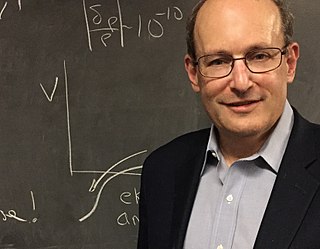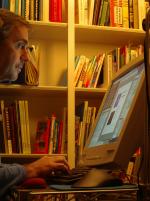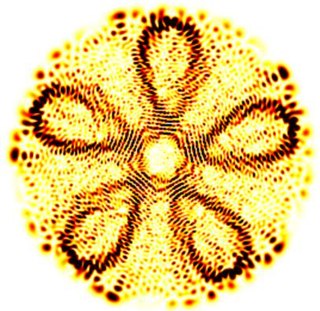Related Research Articles

A black hole is a region of spacetime where gravity is so strong that nothing, including light and other electromagnetic waves, is capable of possessing enough energy to escape it. Einstein's theory of general relativity predicts that a sufficiently compact mass can deform spacetime to form a black hole. The boundary of no escape is called the event horizon. A black hole has a great effect on the fate and circumstances of an object crossing it, but it has no locally detectable features according to general relativity. In many ways, a black hole acts like an ideal black body, as it reflects no light. Quantum field theory in curved spacetime predicts that event horizons emit Hawking radiation, with the same spectrum as a black body of a temperature inversely proportional to its mass. This temperature is of the order of billionths of a kelvin for stellar black holes, making it essentially impossible to observe directly.

General relativity, also known as the general theory of relativity and Einstein's theory of gravity, is the geometric theory of gravitation published by Albert Einstein in 1915 and is the current description of gravitation in modern physics. General relativity generalizes special relativity and refines Newton's law of universal gravitation, providing a unified description of gravity as a geometric property of space and time or four-dimensional spacetime. In particular, the curvature of spacetime is directly related to the energy and momentum of whatever matter and radiation are present. The relation is specified by the Einstein field equations, a system of second order partial differential equations.

Quantum gravity (QG) is a field of theoretical physics that seeks to describe gravity according to the principles of quantum mechanics. It deals with environments in which neither gravitational nor quantum effects can be ignored, such as in the vicinity of black holes or similar compact astrophysical objects, such as neutron stars as well as in the early stages of the universe moments after the Big Bang.

Quantum entanglement is the phenomenon of a group of particles being generated, interacting, or sharing spatial proximity in such a way that the quantum state of each particle of the group cannot be described independently of the state of the others, including when the particles are separated by a large distance. The topic of quantum entanglement is at the heart of the disparity between classical and quantum physics: entanglement is a primary feature of quantum mechanics not present in classical mechanics.
The following is a timeline of gravitational physics and general relativity.

Space debris are defunct human-made objects in space – principally in Earth orbit – which no longer serve a useful function. These include derelict spacecraft, mission-related debris, and particularly-numerous in-Earth orbit, fragmentation debris from the breakup of derelict rocket bodies and spacecraft. In addition to derelict human-made objects left in orbit, space debris includes fragments from disintegration, erosion, or collisions; solidified liquids expelled from spacecraft; unburned particles from solid rocket motors; and even paint flecks. Space debris represents a risk to spacecraft.

The Laser Interferometer Space Antenna (LISA) is a planned space probe to detect and accurately measure gravitational waves—tiny ripples in the fabric of spacetime—from astronomical sources. LISA will be the first dedicated space-based gravitational-wave observatory. It aims to measure gravitational waves directly by using laser interferometry. The LISA concept has a constellation of three spacecraft arranged in an equilateral triangle with sides 2.5 million kilometres long, flying along an Earth-like heliocentric orbit. The distance between the satellites is precisely monitored to detect a passing gravitational wave.
Micro black holes, also called mini black holes or quantum mechanical black holes, are hypothetical tiny black holes, for which quantum mechanical effects play an important role. The concept that black holes may exist that are smaller than stellar mass was introduced in 1971 by Stephen Hawking.
Numerical relativity is one of the branches of general relativity that uses numerical methods and algorithms to solve and analyze problems. To this end, supercomputers are often employed to study black holes, gravitational waves, neutron stars and many other phenomena described by Einstein's theory of general relativity. A currently active field of research in numerical relativity is the simulation of relativistic binaries and their associated gravitational waves.

Paul Joseph Steinhardt is an American theoretical physicist whose principal research is in cosmology and condensed matter physics. He is currently the Albert Einstein Professor in Science at Princeton University, where he is on the faculty of both the Departments of Physics and of Astrophysical Sciences.
The Penrose interpretation is a speculation by Roger Penrose about the relationship between quantum mechanics and general relativity. Penrose proposes that a quantum state remains in superposition until the difference of space-time curvature attains a significant level.

Predrag Cvitanović is a theoretical physicist regarded for his work in nonlinear dynamics, particularly his contributions to periodic orbit theory.

The Lunar Crater Observation and Sensing Satellite (LCROSS) was a robotic spacecraft operated by NASA. The mission was conceived as a low-cost means of determining the nature of hydrogen detected at the polar regions of the Moon. Launched immediately after discovery of lunar water by Chandrayaan-1, the main LCROSS mission objective was to further explore the presence of water in the form of ice in a permanently shadowed crater near a lunar polar region. It was successful in confirming water in the southern lunar crater Cabeus.
Objective-collapse theories, also known spontaneous collapse models or dynamical reduction models, are proposed solutions to the measurement problem in quantum mechanics. As with other interpretations of quantum mechanics, they are possible explanations of why and how quantum measurements always give definite outcomes, not a superposition of them as predicted by the Schrödinger equation, and more generally how the classical world emerges from quantum theory. The fundamental idea is that the unitary evolution of the wave function describing the state of a quantum system is approximate. It works well for microscopic systems, but progressively loses its validity when the mass / complexity of the system increases.
Teleportation is a fictional transfer of matter or energy from one point to another without traversing the physical space between them. It is a common subject in science fiction literature and in other popular culture. Teleportation is often paired with time travel, being that the travelling between the two points takes an unknown period of time, sometimes being immediate. An apport is a similar phenomenon featured in parapsychology and spiritualism.
Frame-dragging is an effect on spacetime, predicted by Albert Einstein's general theory of relativity, that is due to non-static stationary distributions of mass–energy. A stationary field is one that is in a steady state, but the masses causing that field may be non-static — rotating, for instance. More generally, the subject that deals with the effects caused by mass–energy currents is known as gravitoelectromagnetism, which is analogous to the magnetism of classical electromagnetism.

Quantum scarring refers to a phenomenon where the eigenstates of a classically chaotic quantum system have enhanced probability density around the paths of unstable classical periodic orbits. The instability of the periodic orbit is a decisive point that differentiates quantum scars from the more trivial observation that the probability density is enhanced in the neighborhood of stable periodic orbits. The latter can be understood as a purely classical phenomenon, a manifestation of the Bohr correspondence principle, whereas in the former, quantum interference is essential. As such, scarring is both a visual example of quantum-classical correspondence, and simultaneously an example of a (local) quantum suppression of chaos.
The Free-orbit Experiment with Laser Interferometry X-Rays (FELIX) belongs to a category of experiments exploring whether macroscopic systems can be in superposition states. It was originally proposed by the physicist Roger Penrose in his 2004 book The Road to Reality specifically to prove whether unconventional decoherence processes such as gravitationally induced decoherence or spontaneous wave-function collapse of a quantum system occur.
The Micro-Satellite à traînée Compensée pour l'Observation du Principe d'Equivalence is a 300-kilogram (660 lb) class minisatellite operated by CNES to test the universality of free fall with a precision to the order of 10−15, 100 times more precise than can be achieved on Earth. It was launched on 25 April 2016 alongside Sentinel-1B and other small satellites, and was decommissioned around 18 October 2018 after completion of its science objectives. The final report was published in 2022.
Gravitational decoherence is a term for hypothetical mechanisms by which gravitation can act on quantum mechanical systems to produce decoherence. Advocates of gravitational decoherence include Frigyes Károlyházy, Roger Penrose and Lajos Diósi.
References
- ↑ "Satellite imagery company Planet Labs is going public, backed by Google, BlackRock and Marc Benioff". CNBC. July 7, 2021. Retrieved August 2, 2023.
- 1 2 3 4 Vance, Ashlee (2023). "Chapters 1 through 7". When the Heavens Went on Sale: The Misfits and Geniuses Racing to Put Space Within Reach. Ecco. ISBN 978-0062998880.
- ↑ Marshall, William; Simon, Christoph; Penrose, Roger; Bouwmeester, Dik (2003). "Towards quantum superpositions of a mirror". Phys. Rev. Lett. 91 (13): 130401. arXiv: quant-ph/0210001 . Bibcode:2003PhRvL..91m0401M. doi:10.1103/PhysRevLett.91.130401. PMID 14525288. S2CID 16651036.
- ↑ Colaprete, Anthony; Schultz, Peter; Heldmann, Jennifer; Wooden, Diane; Shirley, Mark; Ennico, Kimberly; Hermalyn, Brendan; Marshall, William; Ricco, Antonio; Elphic, Richard C.; Goldstein, David; Summy, Dustin; Bart, Gwendolyn D.; Asphaug, Erik; Korycansky, Don; Landis, David; Sollitt, Luke (2010). "Detection of Water in the LCROSS Ejecta Plume". Science. 330 (6003): 463–468. Bibcode:2010Sci...330..463C. doi:10.1126/science.1186986. PMID 20966242. S2CID 206525375.
- ↑ "The Wet Side of the Moon". New York Times . November 19, 2009. Retrieved August 2, 2023.
- ↑ Mason, James; Stupl, Jan; Marshall, William; Levit, Creon (2011). "Orbital debris–debris collision avoidance". Advances in Space Research. 48 (10): 1643–1655. arXiv: 1103.1690 . Bibcode:2011AdSpR..48.1643M. doi:10.1016/j.asr.2011.08.005. S2CID 118566583.
- ↑ "How I built this, Planet: Will Marshall and Robbie Schingler, episode 383". NPR. December 13, 2021. Retrieved August 2, 2023.
- ↑ "Tiny satellites show us the Earth as it changes in near-real-time". TED. 2014. Retrieved August 2, 2023.
- ↑ "The mission to create a searchable database of Earth's surface". TED. 2018. Retrieved August 2, 2023.